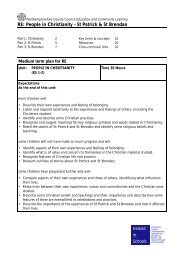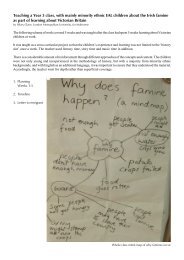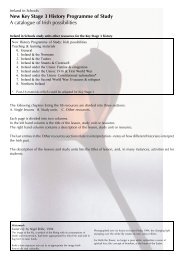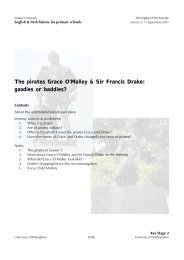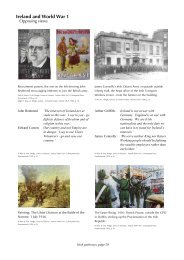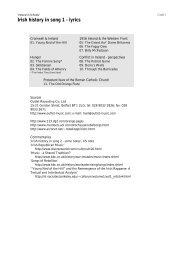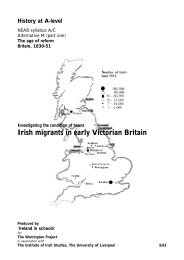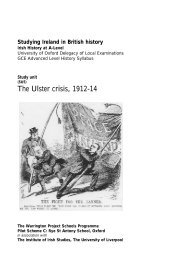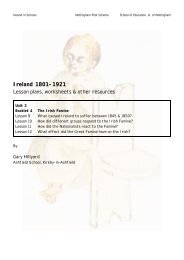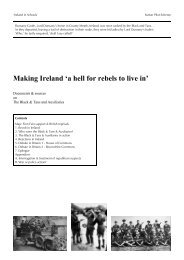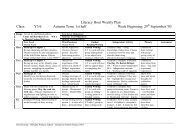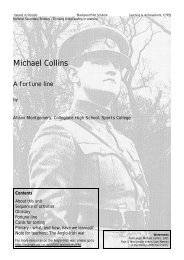Brian Boru & the Vikings - Ireland in Schools
Brian Boru & the Vikings - Ireland in Schools
Brian Boru & the Vikings - Ireland in Schools
You also want an ePaper? Increase the reach of your titles
YUMPU automatically turns print PDFs into web optimized ePapers that Google loves.
Source 2<br />
Morgan Llywelyn, <strong>Brian</strong> <strong>Boru</strong>, O Brien Press, Dubl<strong>in</strong> 1990<br />
<strong>Brian</strong> <strong>Boru</strong> grow up <strong>in</strong> an <strong>Ireland</strong> torn by wars - chiefta<strong>in</strong> aga<strong>in</strong>st chiefta<strong>in</strong>, tribe aga<strong>in</strong>st<br />
tribe - and devastated by <strong>the</strong> <strong>Vik<strong>in</strong>gs</strong>. As a boy, <strong>Brian</strong> wanted to be a mighty warrior, and<br />
when his family were massacred by <strong>the</strong> <strong>Vik<strong>in</strong>gs</strong>, his only aim was to defeat <strong>the</strong>se enemies<br />
forever. But <strong>Brian</strong> was not just a fearless fighter, he was a clever, educated man. He<br />
learned <strong>the</strong> wars of his enemies and overcame opposition, prejudice and treachery to<br />
become High K<strong>in</strong>g of <strong>Ireland</strong>. In <strong>the</strong> famous Battle of Clontarf <strong>in</strong> 1014 <strong>Brian</strong> <strong>Boru</strong> f<strong>in</strong>ally<br />
conquered <strong>the</strong> Vik<strong>in</strong>g. It was his last act.<br />
Source 3<br />
Philippa W<strong>in</strong>gate and Anne Millard, The Vik<strong>in</strong>g World, <br />
In <strong>the</strong> eighth century, <strong>Ireland</strong> was a very prosperous country. It was divided <strong>in</strong>to several<br />
k<strong>in</strong>gdoms, but <strong>the</strong> k<strong>in</strong>gs were united under one leader called <strong>the</strong> High K<strong>in</strong>g. Irish<br />
monasteries had become <strong>the</strong> focus of learn<strong>in</strong>g and of great wealth and were a good target<br />
for <strong>the</strong> <strong>Vik<strong>in</strong>gs</strong>. Raiders first appeared <strong>in</strong> <strong>the</strong> 799s and carried out swift, vicious raids on<br />
isolated coastal villages and monasteries.<br />
In 839, <strong>the</strong> <strong>Vik<strong>in</strong>gs</strong> came <strong>in</strong> large numbers. Norwegian fleets arrived and <strong>the</strong> warriors built<br />
fortified camps where <strong>the</strong>y spent <strong>the</strong> w<strong>in</strong>ter. These camps grow <strong>in</strong>to <strong>Ireland</strong>‘s first cities<br />
such as Dubl<strong>in</strong>, Wexford, Waterford and Cork.<br />
Merchants from all over <strong>the</strong> Vik<strong>in</strong>g world came to buy and sell goods at <strong>the</strong> trad<strong>in</strong>g camps<br />
or long-phorts, br<strong>in</strong>g<strong>in</strong>g wealth to <strong>Ireland</strong>. The <strong>Vik<strong>in</strong>gs</strong> built Scand<strong>in</strong>avian style houses<br />
and craftsmen made goods <strong>in</strong>fluenced by Norse tastes. Many Norwegians married Irish<br />
women and settled <strong>in</strong> <strong>the</strong> towns and became farmers.<br />
The Irish tried many times to drive out <strong>the</strong> Vik<strong>in</strong>g <strong>in</strong>truders. Their best chance came at <strong>the</strong><br />
beg<strong>in</strong>n<strong>in</strong>g of <strong>the</strong> eleventh century.<br />
UCN, <strong>Brian</strong> <strong>Boru</strong> - national hero, page 16



